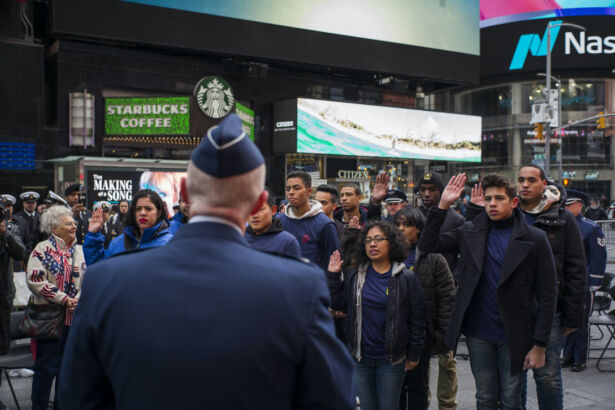The U.S. Navy expects to be 7,000 new sailors short of its annual recruiting goal when the fiscal year ends this month.
At a Senate Armed Services Committee hearing on Thursday, acting Chief of Naval Operations Adm. Lisa Franchetti announced that the service is on track to miss its fiscal year 2023 goal—ending Sept. 30—to bring in 37,700 active duty enlisted sailors. The service also aimed to recruit 2,528 active duty officers, 8,200 reserve enlisted sailors, and 1,940 reserve officers.
Adm. Franchetti’s latest recruiting projection is worse than the 6,000-recruit miss she predicted in April, but not the worst outcome Navy officials have considered this year.
“We started out the year thinking we’d be about 13,000 short,” Adm. Franchetti told Senators on Thursday. “We’re going to be about 7,000 short. We’re doing better month by month than we were last year.”
NTD News reached out to the Navy for additional comment about its recruiting efforts this year, but did not receive a response by the time this article was published.
The Navy brought out several new measures to drive recruiting this year, including raising the maximum enlistment bonus to $75,000 and increasing the maximum enlistment age to 41.
The service also changed its standards to allow recruiters to take candidates who scored in the 10th to 30th percentile on the Armed Forces Qualification Test (AFQT). The revised standards permitted recruiters to fill around 20 percent of their fiscal year 2023 quota with candidates who scored in the 10th to 30th percentile on the AFQT, dubbed “Category IV” candidates.
Military Recruiting Woes Stretch Into Second Year
The Navy is not the only military service expecting to fall short of its recruiting quotas for the year. This week, the U.S. Air Force announced it is on track to bring in about 2,700 new airmen fewer than planned for fiscal year 2023, missing this year’s goal to bring in 26,877 recruits by about 10 percent.
The U.S. Space Force—which is organized under the purview of the Department of the Air Force—did manage to overshoot its recruiting quote for the 2023 fiscal year. The newest U.S. military branch brought in 517 new enlisted personnel or about 110 percent of the 472-recruit goal the branch set out for this year.
A spokesperson for the U.S. Marine Corps recruiting command told NTD News that the branch is also on track to hit its recruiting goals this year, but won’t release its year-end figures until next month.

NTD News reached out to the U.S. Army for a status update on its annual recruiting mission, but the service did not respond by the time this article was published. Last week, Army Times reported that the service had met about two-thirds of its goal to bring in 94,000 new soldiers for its active duty and reserve components.
This year’s military-wide recruiting struggle marks the second year in a row that U.S. military services have struggled to find new candidates.
The Navy hit its recruiting goals for active-duty personnel last year but fell short when it came to recruiting new active and reserve officers and reserve enlisted personnel. The service recorded falling short by 209 active-duty officers, 378 reserve officers, and 1,958 reserve enlisted personnel.
The Air Force met its goal for recruiting new active-duty personnel last year, but acknowledged missing its goals for attracting new Air Force Reserve and Air National Guard troops.
The Army saw the largest recruiting shortfall of the fiscal year 2022, coming in 15,000 recruits short of its 60,000 recruit goal—a 25 percent miss.
Tough, Political Recruiting Environment
Some military officials have attributed the recruiting shortfalls to a range of factors from a competitive job market to declining fitness.
This week, Air Force Recruiting Service spokeswoman Leslie Brown told NTD News that a national labor shortage and overall low unemployment rate means military recruiters are competing with other sectors of society for solid candidates. She also said many people simply don’t meet the eligibility requirements to serve.
A 2020 Department of Defense assessment (pdf) concluded that about 77 percent of Americans between 17 and 24 years old would be ineligible to serve without some form of waiver.
Reasons for this ineligibility included being overweight, having a drug use problem, and other disqualifying health conditions.
A figure of 44 percent of 17 to 24-year-olds in the assessment would be ineligible as a result of multiple factors, while 11 percent of people in the study would be disqualified as a result of weight issues alone, and eight percent would be disqualified as a result of their drug use.

Lawmakers on either side of the political aisle have attributed the recruiting woes to other problems entirely.
Sen. Marco Rubio (R-Fla.) and Rep. Chip Roy (R-Texas) published a report (pdf) last year detailing what they see as a disruptive politicization of the military by President Joe Biden’s administration.
The Republican lawmakers wrote that “the Biden Administration’s divisive rhetoric and propaganda continue to bring down the military’s already-low recruitment numbers.”
Some active-duty troops have also raised concerns that the political direction of the military is hindering recruiting efforts.
In July, Gallup pollsters reported the lowest level of confidence in the U.S. military among the U.S. public in 26 years. The Gallup pollsters found that the most significant drop in confidence in the military came from Republicans, who had held the highest confidence in that institution across the poll’s history.
During the Thursday Senate hearing, Sen. Elizabeth Warren (D-Mass.) blamed Sen. Tommy Tuberville (R-Ala.) for damaging military recruiting efforts by slowing the process by which the Senate confirms military promotions and nominations. Mr. Tuberville is slowing the nomination process as a means of pressuring the Department of Defense to retract an abortion travel policy that he argues is at odds with current federal laws.
“The senator’s actions are damaging our military’s recruiting and we will be paying a price for decades to come,” Ms. Warren said of the actions of her Republican counterpart.
Around 300 military officers are currently awaiting Senate action on their promotions and nominations, including Adm. Franchetti.

